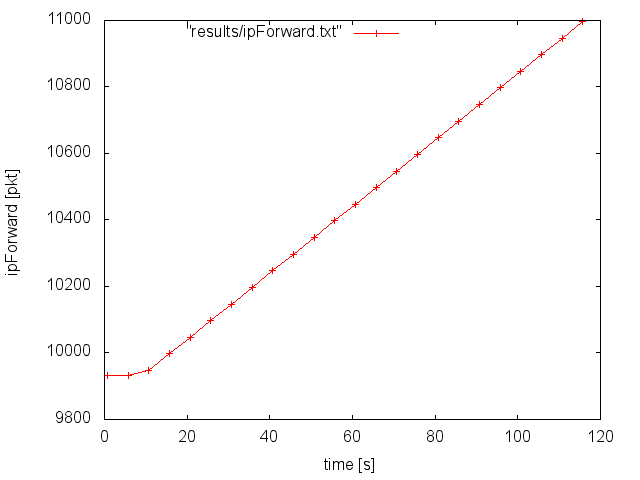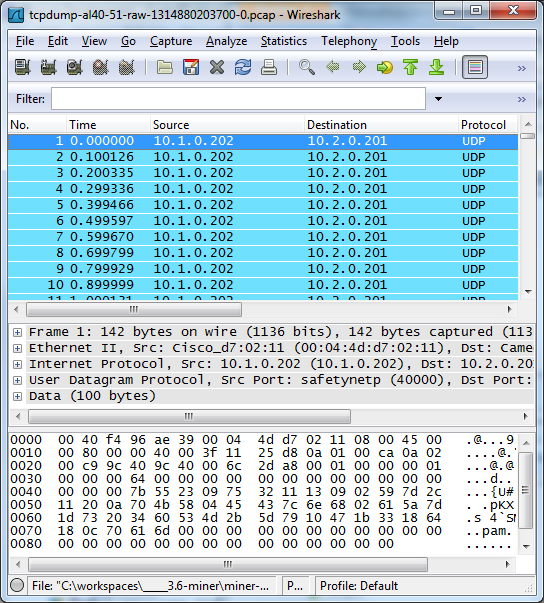Sample application
Introduction
The following MINER sample application shows a Scenario that makes use of some MinerTools and illustrates several concepts of MINER with still being a simple application. The Scenario is then executed in a private testbed. The figure depicts the setup of the scenario.

Between ToolProxies al40-202 and al40-201 delay, jitter, and loss are actively measured according to an IPPM standard.
On ToolProxy al40-51, 2 different MinerTools are employed. The SnifferTool is used to capture network traffic on the interface that faces router R1. The libpcap-based tool produces a binary trace in pcap format as well as throughput data (in pkt/s) averaged over 1s intervals. Additionally, the NetemTool, which is based on the Linux NETEM functionality, is used to emulate delay.
Finally, an SNMPTool is employed on ToolProxy al40-204. It periodically sends SNMP queries to router R1.
The MINER Core is located on host al40-47 which is not shown in the figure.
Application code
Below is a listing of the sample application.
/**
* (C) Salzburg Research Forschungsgesellschaft mbH. All rights reserved.
*/
package at.srfg.miner;
import java.io.File;
import java.util.ArrayList;
import java.util.Date;
import java.util.List;
import at.srfg.miner.clientlib.Action;
import at.srfg.miner.clientlib.Condition;
import at.srfg.miner.clientlib.Execution;
import at.srfg.miner.clientlib.Proxy;
import at.srfg.miner.clientlib.Result;
import at.srfg.miner.clientlib.ResultHandle;
import at.srfg.miner.clientlib.Results;
import at.srfg.miner.clientlib.Scenario;
import at.srfg.miner.clientlib.Task;
import at.srfg.miner.clientlib.resultformat.ResultFormatter;
/**
* This application uses various Tools in a Scenario executed in a Salzburg
* Research testbed.
*/
public class ManualApp {
private static final int DURATION = 120; // [s]
public static void main(String[] args) throws Exception {
System.setProperty("miner.rest", "http://al40-47:8008/rest");
Scenario s = new Scenario("A MINER sample application");
s.setDescription("This application is used as a sample in the manual.");
s.addKeyword("Manual");
Task active = s.addTask("Active");
Task passive = s.addTask("Passive");
Task emulation = s.addTask("Emulation");
//
// All actions in the 'active' task start 10 seconds after the start of
// the execution.
//
active.setDeltaStart(10);
//
// IPPMTool: active traffic generation from al40-202 to al40-201
//
Action aIPPM = active.addAction("IPPM");
Proxy receiver = aIPPM.addProxy("al40-201");
aIPPM.addProxy("al40-202");
aIPPM.setTool("IPPMTool");
aIPPM.setToolconfig(new File("etc/ippm.xml"));
// IPPM lossAvg
ResultHandle hLoss = aIPPM.produce("lossRatio")
.configure("interval", 5)
.configure("lossThreshold", 10)
.setSavePattern("ippmLoss")
.setQueryProxies(receiver);
// IPPM 1-way delay measured via kernel-level timestamps
ResultHandle hOwdPcap = aIPPM.produce("owdPcap");
// Trigger an alarm if the delay >= 100ms
aIPPM.addCondition(Condition.ALL).addSubcondition(hOwdPcap, "<", 50000);
//
// SnifferTool on al40-51 / eth1
//
Action aSniffer = passive.addAction("SnifferIngress");
aSniffer.addProxy("al40-51");
aSniffer.setTool("SnifferTool");
aSniffer.setToolconfig(new File("etc/sniffer.xml"));
// Sniffer throughput as pkt/s
ResultHandle hTputPkt = aSniffer.produce("tputPkt")
.configure("interval", 1);
// Sniffer pcap dump file
ResultHandle hTrace = aSniffer.produce("raw")
.setSavePattern("tcpdump-.pcap");
//
// SNMPTool on al40-168
//
Action aSNMP = passive.addAction("SNMP");
aSNMP.addProxy("al40-204");
aSNMP.setTool("SNMPTool");
aSNMP.setToolconfig(new File("etc/snmp.xml"));
// SNMP query ipForward
ResultHandle hIpForward = aSNMP.produce("SNMPValue")
.setSelector("1.3.6.1.2.1.4.6.0")
.setSavePattern("ipForward");
// SNMP query routerInfo
ResultHandle hRouterInfo = aSNMP.produce("SNMPTree")
.setSelector("1.3.6.1.2.1")
.setSavePattern("snmpTree");
//
// NETEMTool on al40-51
// emulates delay of 100ms
//
Action aNetem = emulation.addAction("Netem");
aNetem.setDeltaStart(60);
aNetem.setDuration(30);
aNetem.addProxy("al40-51");
aNetem.setTool("NetemTool");
aNetem.setToolconfig(new File("etc/netem.xml"));
// we request no result from this tool
//
//
// The Scenario specification is complete.
//
// SUBMIT it to the Server
//
s.submit();
//
// Schedule the Scenario for execution
// start now and run for DURATION seconds
//
Date start = new Date();
Date stop = new Date(start.getTime() + DURATION * 1000);
Execution exec = s.schedule(start, stop, "My first scenario execution");
// During the execution we query the tputPkt every 5 seconds and print
// timestamp / value pairs.
List<Result> tputResults = new ArrayList<Result>();
while (!exec.isFinished()) {
Thread.sleep(5000);
List<Result> results = exec.nextResults(hTputPkt);
if (!results.isEmpty()) {
Results.print(results);
tputResults.addAll(results);
}
}
// get the remaining tputPkt results (if any)
tputResults.addAll(exec.nextResults(hTputPkt));
// Get and print the excecutionlog
System.out.println(exec.getLog());
// Save all results to subdirectory 'results'
Results.setSaveDir(new File("results"));
// get the binary pcap trace
// note that binary results are automatically saved to disk
exec.allResults(hTrace);
// Finally, save some results to the filesystem
Results.save(tputResults, "tput.txt");
Results.getAndSave(exec, hOwdPcap, hLoss, hIpForward);
}
}
Configuration files
ippm.xml
<?xml version="1.0" encoding="UTF-8"?> <IPPMTool xmlns="https://miner.salzburgresearch.at/xml/ns/tool/ippmtool"> <srcIP>10.1.0.202</srcIP> <dstIP>10.2.0.201</dstIP> <srcPort>40000</srcPort> <dstPort>40000</dstPort> <payloadSize>100</payloadSize> <const>100000</const> </IPPMTool>
sniffer.xml
<?xml version="1.0" encoding="UTF-8"?> <SnifferTool xmlns="https://miner.salzburgresearch.at/xml/ns/tool/sniffertool"> <IP>10.16.0.2</IP> <filterString>udp and port 40000</filterString> </SnifferTool>
snmp.xml
<?xml version="1.0" encoding="UTF-8"?> <SNMPTool xmlns="https://miner.salzburgresearch.at/xml/ns/tool/snmptool"> <Community>topsecret</Community> <Address>192.168.40.2</Address> <Timeout>2000</Timeout> <Retries>3</Retries> <Pause>5000</Pause> </SNMPTool>
netem.xml
<?xml version="1.0" encoding="UTF-8"?> <NetemTool xmlns="https://miner.salzburgresearch.at/xml/ns/tool/netemtool"> <device>eth2</device> <action> <delay> <value>100</value> </delay> </action> </NetemTool>
Comments
IPPM lossRatio result request
- The result class lossRatio has a required configuration parameter interval: the time interval over which the average is computed.
- Additionally we set the optional configuration parameter lossThreshold: if a packet is received with a delay > lossThreshold it is considered as lost.
- As the IPPMTool results are exclusively produced at the receiver, we restrict the result query to the receiver ToolProxy.
Condition on the delay result
We define that the measured delay must be smaller than 95ms. As NETEM is configured to emulate a delay of 100ms between 60-90s of the experiment, we expect condition violation alarms in the Executionlog.
SNMP results
The SNMPTool can be used to retrieve a huge number of different results, depending on the OID used in an SNMP GET and WALK, for example. The number of available queries is so large, that they are not registered individually as single results at the MINER Core. Instead, the SNMP tool makes use of the selector mechanism that is available to MinerTool developers. Instead of registering an individual result, the tool developer registers a result “template” like SNMPValue. This result must then be requested with additional selector to provide a fully specified result request. For the SNMPTool, the selector is the OID to be used for the query. Therefore, the result request for ipForwarding statistics looks like:
aSNMP.produce("SNMPValue").setSelector("1.3.6.1.2.1");
Getting results during the execution
To see some results during the execution, the tputPkt result is queried every 5 seconds. As we want to save those results to a file later on, we collect them (to avoid an additional query for all results after the execution has finished).
Execution aftermath
After the execution has finished, we first get and print the executionlog. Note that the log contains the condition violations as expected.
Then we make various uses of the Results class to demonstrate some of its capabilities. The binary pcap trace is retrieved and automatically saved to disk. Before proceeding, the directory for saving results is set. This directory is used in the subsequent save/getAndSave calls. The binary pcap trace is retrieved and saved automatically because binary results are always saved to disk. The tputPkt results that were collected during the execution are then saved to a file. Finally, the hOwdPcap, hLoss, and hIpForward results are retrieved and saved to individual files. Note that the savePatterns of hLoss and hIpForward are used. The result hRouterInfo is not loaded from the MINER Core in this scenario.
Results
Executionlog
The Executionlog contained the following output.
2011-09-01 14:28:04.0 INFO Execution 7 deployed 2011-09-01 14:28:04.0 INFO Tool init ok [execId=7/al40-51/Netem/NetemTool] 2011-09-01 14:28:04.0 INFO Tool init ok [execId=7/al40-204/SNMP/SNMPTool] 2011-09-01 14:28:04.0 INFO Tool init ok [execId=7/al40-201/IPPM/IPPMTool] 2011-09-01 14:28:04.0 INFO Tool init ok [execId=7/al40-202/IPPM/IPPMTool] 2011-09-01 14:28:04.0 INFO Tool init ok [execId=7/al40-51/SnifferIngress/SnifferTool] 2011-09-01 14:28:04.0 INFO Entering tool run [execId=7/al40-51/SnifferIngress/SnifferTool] 2011-09-01 14:28:04.0 INFO Entering tool run [execId=7/al40-204/SNMP/SNMPTool] 2011-09-01 14:28:13.0 INFO Entering tool run [execId=7/al40-201/IPPM/IPPMTool] 2011-09-01 14:28:13.0 INFO Entering tool run [execId=7/al40-202/IPPM/IPPMTool] 2011-09-01 14:29:03.0 INFO Entering tool run [execId=7/al40-51/Netem/NetemTool] 2011-09-01 14:29:03.0 INFO Netem options reset for device eth2 successfully completed [execId=7/al40-51/Netem/NetemTool] 2011-09-01 14:29:03.0 INFO Adding options [execId=7/al40-51/Netem/NetemTool] 2011-09-01 14:29:03.0 INFO All options set [execId=7/al40-51/Netem/NetemTool] 2011-09-01 14:29:04.0 WARN Condition violation: subcondition 'owdPcap < 50000.0' violated by owdPcap value of '100303.0'. 2011-09-01 14:29:14.0 WARN Condition violation: subcondition 'owdPcap < 50000.0' violated by owdPcap value of '100235.0'. 2011-09-01 14:29:25.0 WARN Condition violation: subcondition 'owdPcap < 50000.0' violated by owdPcap value of '100285.0'. 2011-09-01 14:29:33.0 INFO Entering tool finish [execId=7/al40-51/Netem/NetemTool] 2011-09-01 14:29:33.0 INFO Netem options reset for device eth2 successfully completed [execId=7/al40-51/Netem/NetemTool] 2011-09-01 14:29:33.0 INFO Action finished [execId=7/al40-51/Netem/NetemTool] 2011-09-01 14:30:03.0 INFO Entering tool finish [execId=7/al40-202/IPPM/IPPMTool] 2011-09-01 14:30:03.0 INFO Sender capture statistic Received packets: 1100 Dropped packets : 0 Sent 1100 [execId=7/al40-202/IPPM/IPPMTool] 2011-09-01 14:30:03.0 INFO Action finished [execId=7/al40-202/IPPM/IPPMTool] 2011-09-01 14:30:03.0 INFO Entering tool finish [execId=7/al40-51/SnifferIngress/SnifferTool] 2011-09-01 14:30:03.0 INFO Sniffer info: Packets received : 1100 Packets captured : 1100 Packets dropped : 0 [execId=7/al40-51/SnifferIngress/SnifferTool] 2011-09-01 14:30:03.0 INFO Action finished [execId=7/al40-51/SnifferIngress/SnifferTool] 2011-09-01 14:30:03.0 INFO Entering tool finish [execId=7/al40-201/IPPM/IPPMTool] 2011-09-01 14:30:03.0 INFO Receiver capture statistic Received packets: 1100 Dropped packets : 0 [execId=7/al40-201/IPPM/IPPMTool] 2011-09-01 14:30:04.0 INFO Action finished [execId=7/al40-201/IPPM/IPPMTool] 2011-09-01 14:30:04.0 INFO Entering tool finish [execId=7/al40-204/SNMP/SNMPTool] 2011-09-01 14:30:04.0 INFO Action finished [execId=7/al40-204/SNMP/SNMPTool] 2011-09-01 14:30:04.0 INFO Execution 7 finished
Note that the condition violations are reported as expected. The MINER Core was configured to report the violation of a Condition at most once every 10 seconds.
Result files
The results directory contains the following files:
$ ls results/ ipForward.txt owdPcap.txt tput.txt ippmLoss.txt tcpdump-al40-51-raw-1314880203700-0.pcap
Visualisation of result data
Throughput
The following figure shows the throughput measured by the SnifferTool.

One-way delay
The following figure shows the one-way delay measured by the IPPMTool. Note that the delay is virtually 0 (all hosts are located in the same room) unless for the period between 60 and 90 seconds where the WAN emulator NETEM emulated a delay of 100ms.

IP forwarding
The following figure shows the IP forwarding numbers of the router R1. They were obtained by periodic SNMP queries of the router.

Pcap trace
The following figure shows a screenshot where the binary pcap trace which was produced by the SnifferTool is loaded in wireshark.

